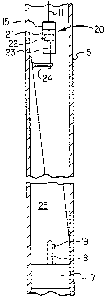Une partie des informations de ce site Web a été fournie par des sources externes. Le gouvernement du Canada n'assume aucune responsabilité concernant la précision, l'actualité ou la fiabilité des informations fournies par les sources externes. Les utilisateurs qui désirent employer cette information devraient consulter directement la source des informations. Le contenu fourni par les sources externes n'est pas assujetti aux exigences sur les langues officielles, la protection des renseignements personnels et l'accessibilité.
L'apparition de différences dans le texte et l'image des Revendications et de l'Abrégé dépend du moment auquel le document est publié. Les textes des Revendications et de l'Abrégé sont affichés :
| (12) Brevet: | (11) CA 2192185 |
|---|---|
| (54) Titre français: | PROCEDE PERMETTANT DE PLACER UN SIFFLET DEVIATEUR DANS UN PUITS DE FORAGE |
| (54) Titre anglais: | METHOD FOR SETTING A WHIPSTOCK IN A WELLBORE |
| Statut: | Durée expirée - au-delà du délai suivant l'octroi |
| (51) Classification internationale des brevets (CIB): |
|
|---|---|
| (72) Inventeurs : |
|
| (73) Titulaires : |
|
| (71) Demandeurs : |
|
| (74) Agent: | NORTON ROSE FULBRIGHT CANADA LLP/S.E.N.C.R.L., S.R.L. |
| (74) Co-agent: | |
| (45) Délivré: | 2001-07-24 |
| (86) Date de dépôt PCT: | 1995-05-25 |
| (87) Mise à la disponibilité du public: | 1995-12-14 |
| Requête d'examen: | 1997-06-05 |
| Licence disponible: | S.O. |
| Cédé au domaine public: | S.O. |
| (25) Langue des documents déposés: | Anglais |
| Traité de coopération en matière de brevets (PCT): | Oui |
|---|---|
| (86) Numéro de la demande PCT: | PCT/GB1995/001196 |
| (87) Numéro de publication internationale PCT: | GB1995001196 |
| (85) Entrée nationale: | 1996-12-05 |
| (30) Données de priorité de la demande: | ||||||
|---|---|---|---|---|---|---|
|
Un procédé permet de placer un sifflet déviateur (25) dans un puits de forage (2) sur un ancrage-garniture d'étanchéité (17). Il consiste à utiliser un câble métallique (11) qui porte un ensemble de placement (20, 35) chargé de couper un élément de cisaillement (24, 33) porté par cet ensemble de placement, une fois que le sifflet déviateur est en place sur l'ancrage-garniture d'étanchéité.
A method for setting a whipstock (25) in a wellbore (2) on a packer-anchor (17)
which employs a wireline (11) that carries a setting assembly (20, 35) which severs a
shear member (24, 33) carried by the setting assembly after the whipstock is set onto the
packer-anchor.
Note : Les revendications sont présentées dans la langue officielle dans laquelle elles ont été soumises.
Note : Les descriptions sont présentées dans la langue officielle dans laquelle elles ont été soumises.

2024-08-01 : Dans le cadre de la transition vers les Brevets de nouvelle génération (BNG), la base de données sur les brevets canadiens (BDBC) contient désormais un Historique d'événement plus détaillé, qui reproduit le Journal des événements de notre nouvelle solution interne.
Veuillez noter que les événements débutant par « Inactive : » se réfèrent à des événements qui ne sont plus utilisés dans notre nouvelle solution interne.
Pour une meilleure compréhension de l'état de la demande ou brevet qui figure sur cette page, la rubrique Mise en garde , et les descriptions de Brevet , Historique d'événement , Taxes périodiques et Historique des paiements devraient être consultées.
| Description | Date |
|---|---|
| Inactive : Périmé (brevet - nouvelle loi) | 2015-05-25 |
| Lettre envoyée | 2004-05-27 |
| Inactive : Lettre officielle | 2004-02-10 |
| Accordé par délivrance | 2001-07-24 |
| Inactive : Page couverture publiée | 2001-07-23 |
| Inactive : Inventeur supprimé | 2001-05-16 |
| Inactive : Taxe finale reçue | 2001-04-10 |
| Préoctroi | 2001-04-10 |
| Lettre envoyée | 2000-10-13 |
| Un avis d'acceptation est envoyé | 2000-10-13 |
| Un avis d'acceptation est envoyé | 2000-10-13 |
| Inactive : Approuvée aux fins d'acceptation (AFA) | 2000-09-28 |
| Inactive : Acc. réc. RE - Pas de dem. doc. d'antériorité | 1997-09-04 |
| Inactive : Renseign. sur l'état - Complets dès date d'ent. journ. | 1997-08-28 |
| Inactive : Dem. traitée sur TS dès date d'ent. journal | 1997-08-28 |
| Toutes les exigences pour l'examen - jugée conforme | 1997-06-05 |
| Exigences pour une requête d'examen - jugée conforme | 1997-06-05 |
| Demande publiée (accessible au public) | 1995-12-14 |
Il n'y a pas d'historique d'abandonnement
Le dernier paiement a été reçu le 2001-04-25
Avis : Si le paiement en totalité n'a pas été reçu au plus tard à la date indiquée, une taxe supplémentaire peut être imposée, soit une des taxes suivantes :
Les taxes sur les brevets sont ajustées au 1er janvier de chaque année. Les montants ci-dessus sont les montants actuels s'ils sont reçus au plus tard le 31 décembre de l'année en cours.
Veuillez vous référer à la page web des
taxes sur les brevets
de l'OPIC pour voir tous les montants actuels des taxes.
Les titulaires actuels et antérieures au dossier sont affichés en ordre alphabétique.
| Titulaires actuels au dossier |
|---|
| PHILLIPS PETROLEUM COMPANY |
| ATLANTIC RICHFIELD COMPANY |
| CHARLES D. HAILEY |
| Titulaires antérieures au dossier |
|---|
| CHARLES M. HIGHTOWER |
| CURTIS G. BLOUNT |